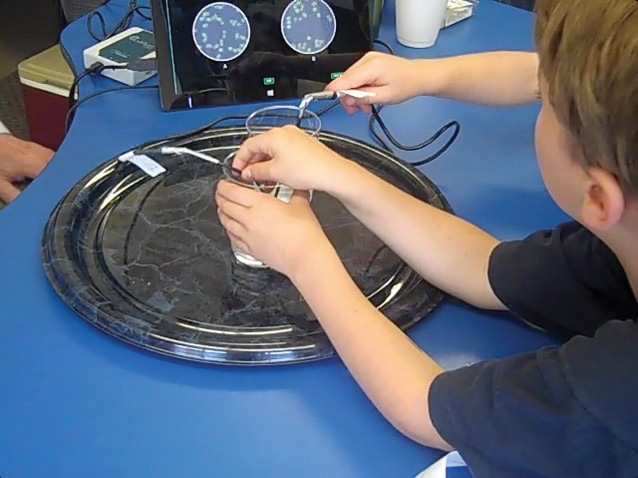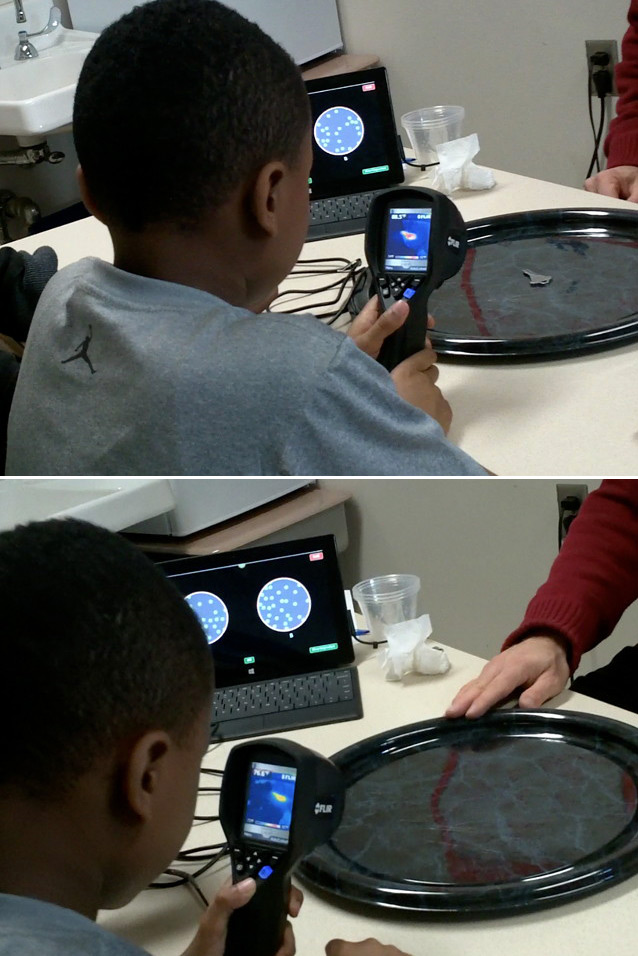Sensing Science: Temperature and Heat Readiness for Early Elementary Students
Young children learn through everyday activity. They invent strategies for exploring the world and develop intuitive understandings of phenomena that surround them. Mixing hot and cold water in the bathtub, putting on a winter coat, and feeling the warmth of a fire or a chill climbing out of a swimming pool are personal experiences that instill concepts of temperature and heat. Children generalize data from these experiences to construct theories of temperature and heat well before they enter formal education. We have found that children as young as four years old have definite ideas about the source of heat and how heat moves through air and objects. These early scientific conceptions are often incorrect, but once established, are tenaciously held.
Research
Our Sensing Science project, funded by the National Science Foundation, is researching “temperature and heat readiness” for K-2 students. During our research, students in kindergarten through second grade performed facilitated explorations or watched interviewers conduct experiments with temperature probes and other physical objects. For example, students mixed hot and cold water, saw a metal pipe being heated and decided which material would best insulate chocolate from a hot light bulb.
When external data conflict with personal theories, children’s naïve conceptions can be reconstructed. These explorations provided students with experiences that confirmed or countered their predictions, and ultimately generated new theories about temperature and heat.
During these explorations we interviewed students to elicit and document their conceptions of temperature and heat rather than to teach. In the first phase of project research, we examined children’s free exploration of temperature and heat concepts using fast-response temperature sensors and infrared (IR) cameras. During the second phase, we piloted and refined an interview process involving verbal prompts and additional tools such as infrared thermometers, thermal clay, and pre-recorded videos and simulations. In the final phase, which is currently under way, we have standardized the explorations and verbal prompts into an interview protocol.
New digital tools
Since heat and temperature are invisible, the Sensing Science team designed new digital tools to help make the invisible visible and link the visualizations directly to children’s tangible perceptions of hot and cold.
IR cameras and IR thermometers. Infrared (IR) cameras and their companion technology, IR thermometers, represent a revolution in the ability to access and understand the invisible world of thermal energy. Once costing tens of thousands of dollars, these cameras are now affordable and contain digital screens, permitting interactive exploration of temperature and heat concepts in new ways.

Graduated-color representations. Children can express their theories about temperature and heat verbally or by referring to pictures or by drawing. They drew temperature using a set of red and blue pencils. For example, they drew gradients of temperature down the length of a heated object. This gives children the opportunity to represent their ideas about temperature explicitly.
Thermoscope. Since heat is generated from the movement of particles, we wanted to provide a simplified visualization of particle movement. (Our goal was not to teach about the particulate nature of matter per se, but to make visible in a schematic manner temperature differences between two materials.) We created a new thermometric representation, called the thermoscope, by connecting a fast-response temperature sensor to a computer model that displayed moving dots inside a circle (Figure 1). Rather than using the display of a conventional thermometer with a rising red line, the computer shows a five-inch circle populated with moving dots. Probing hotter materials causes the dots to move more quickly and collide more frequently. We did our best to explain this display as tiny parts of the material itself in motion and not as little bits of stuff floating inside the material like dirt in water.
By working with this metaphor, could children begin to treat heat not as a hot or cold substance, but as particles that move and bump at different speeds? That is, could they treat temperature as relative speed as opposed to the amount of hotness? Although we were concerned that children would find it improbable that a piece of soapstone had moving parts, students from kindergarten to second grade quickly adopted a new way to refer to hot and cold: hot became “fast-moving particles” and cold became “slow-moving particles.”

We also wanted to know if these action words carried any implication for why temperature changes or for how heat works. In one exploration, the children looked through an IR camera at a metal key that had been heated. The IR camera clearly showed a red (hot) key in the display. When the key was removed from the tray on which it was resting, the red key shape could still be seen in the IR camera (Figure 2). Children invented a number of explanations based on the macroscopic world of one object affecting another, such as “the key made a mark” or “the key made a dent.” A few of the older children said “the heat from the key went into the tray.” Children also used the terms “fast” and “faster” for variations in heat. But we have not heard anything such as “the fast-moving particles in the key make the particles in the tray move faster.”
Results
We have interviewed over 150 children and have begun to characterize their ideas as proposed conceptual levels. (See the project website for current research results.) We have found some well-known preconceptions*, such as thinking that the insulating material in a glove was itself hot without considering its ability to keep the body’s warmth from escaping the glove. Other discoveries are new candidates for where children go wrong and how to help them.
At first, children simply know what is hot (the sun, the stove), but they do not consider that things might warm slowly or warm an adjacent object. Gradually, they understand that heat requires a process that goes from warm to hot, and takes time. They then understand that it is best to treat heat as something other than the hot object itself, something that requires a source such as “turn on the grill” or “set the wood on fire.” At about the same time they understand that heat can move through space (e.g., “it comes from the fireplace through the air”). By eight years old, children know that heat can come from mechanical energy (e.g., “the tires on my bike get hot when I ride fast” or “I can warm my hands by rubbing them together”).
Although temperature and heat are topics usually postponed in school curricula until third grade, it is our belief that basic concepts of thermodynamics can be understood by children much younger. By providing young students with a representation of heat as movement and allowing them to think about invisible particles, we believe students can form critical building blocks for a much later understanding of ideas as foundational as energy and molecular motion.
*Albert, E. (1978). Development of the concept of heat in children. Science Education, 62, 389-399.
Carolyn Staudt (cstaudt@concord.org) directs the Sensing Science project.
George Forman (geforman@aol.com) co-directs the Sensing Science project.
This material is based upon work supported by the National Science Foundation under grant DRL-1222892. Any opinions, findings, and conclusions or recommendations expressed in this material are those of the author(s) and do not necessarily reflect the views of the National Science Foundation.
